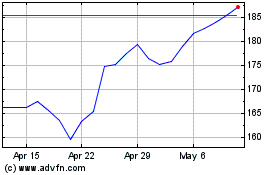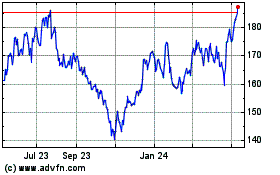Analog Devices’ (ADI) fiscal fourth quarter
earnings missed the Zacks Consensus Estimate by 3 cents, or 4.8%.
Revenue missed the consensus by 8.2%. Particular weakness in the
communications and industrial markets led to weaker-than-expected
revenue. This, in turn, impacted margins.
The guidance was also below our expectations, but the market
appears to have priced in the weakness, given that other analog
players, such as Linear Technology Corp (LLTC),
Maxim Integrated Products (MXIM) and Texas
Instruments (TXN) also guided below expectations.
Therefore, shares did not lose much in after-market trade.
Revenue
Analog Devices generated revenue of $716.1 million, which was
down 5.5% sequentially, 7.0% year over year and just within
management’s revenue guidance of $715-755 million (down 0-6%
sequentially, down 2-7% year over year).
While the industrial segment weakened in line with management
guidance, Analog Devices had guided to strength in communications
infrastructure that did not materialize.
Revenue by End Market
The industrial market generated 41% of Analog
Devices’ total revenue (down 13.9% sequentially and 10.0% year over
year). This is a very diversified market for Analog Devices,
including the industrial automation, instrumentation, energy,
defense and healthcare segments.
The sequential decline in the last quarter was on account of
increased caution at customers, as economic concerns led them to
further reduce inventories. Management stated that the weakness was
broad-based across product lines and geographies. Order flow
started to stabilize through October and November. Analog Devices’
full-year performance was good, however, due to strong revenue
growth in industrial automation, instrumentation and energy
markets.
Consumer, which now includes the computing (1%
of fiscal 2011 revenue) and handset (3% of fiscal 2011 revenue)
businesses, generated 21% of revenue, up 7.9% sequentially and down
9.3% from a year ago. The sequential increase was on account of
seasonal increase in demand for digital cameras, gaming systems and
the like. Sales for the year were down, as Analog Devices shifted
focus to higher value-added applications that are likely to
generate better margins.
Communications generated 19% of total revenue,
down 9.2% sequentially and 14.1% year over year. Analog Devices’
communications business comes from both infrastructure and cell
phones, although the focus is on the infrastructure side. However,
management is now including phones in the consumer segment.
Although revenue in the quarter benefited from the recovery in
Japan, this was more than offset by the postponement of the
build-out in China and overall inventory reduction across the world
due to increased macro concerns. The mobile data segment drove
revenue for the year.
The automotive segment generated around 16% of
Analog Devices’ fourth quarter revenue, increasing 11.2%
sequentially and 20.2% from the year-ago quarter. Growing
electronic content in automobiles and strong position at customers
offset macro pressures to generate the growth in the last
quarter.
The global recovery, better credit availability, as well as
increasing electronic content per vehicle, especially in the areas
of infotainment, safety and fuel efficiency remain long-term
drivers. This, along with increasing demand for high-end vehicles
that use Analog Devices products are positives for the company.
Revenue by Product Line
The revenue decline was across all product lines, including
analog, power management and digital signal processing (DSP).
Analog signal processing products (85% of total revenue) were
down 5.3% sequentially and 6.7% year over year. All product lines
within analog (converters, amplifiers and other analog products)
contributed to the sequential decline, although other analog
products were up year over year.
Converters remained the largest product line for Analog Devices,
with a revenue share of over 45%. Amplifiers followed, with a 26%
revenue share, while other analog products accounted for 14% of
total revenue.
Power management and reference products remained at 7% of
revenue, down 3.3% sequentially and 4.5% from last year. The
strength in this product line is the result of management’s
refocusing of the business over the last few years.
DSPs (8% of total revenue) were down 9.3% sequentially and 12.3%
year over year.
Margins
Analog Devices generated a pro forma gross margin of 64.3%, down
294 basis points (bps) sequentially, 274 bps year over year and
missing management’s guidance of 65-66%. Gross margins were
impacted by a negative mix (more automotive and consumer versus
less industrial and communications) and utilization rates dropping
(from 78% to 73%), as Analog cut production to lower both internal
and distributor inventories.
Operating expenses of $225.2 million were down 2.4% sequentially
and 2.3% from the October quarter of 2010, much less than the
overall decline in revenue. As a result, the operating margin
shrunk 394 bps sequentially and 425 bps year over year to
32.9%.
On a sequential basis, cost of sales increased the most as a
percentage of sales, with R&D and SG&A increasing at more
or less the same rate. All expenses grew year-over-year as a
percentage of sales.
Net Profit
The pro forma net income was $183.5 million, or a 25.6% net
income margin compared to $219.9 million, or 29.0% in the previous
quarter and $225.0 million, or a 29.2% net income margin in the
prior-year quarter. The fully diluted pro forma earnings per share
were 60 cents compared to 71 cents in the previous quarter and 73
cents in the October quarter of last year. The EPS was well below
management’s expectations of 74 cents.
Since there were no one-time items in any of the quarters, the
GAAP and non GAAP net income and EPS were same.
Balance Sheet
Inventories dropped 1.4% to $295.1 million, with annualized
inventory turns dropping flat sequentially at 3.5X. Days sales
outstanding (DSOs) went down to 44 from 45. Cash generated from
operations was around $230.2 million. Analog Devices spent $26.3
million on capex, $74.8 million on cash dividends and $82.8 million
on share repurchases in the last quarter.
Guidance
With customers continuing to cut inventories and typical first
quarter seasonality, Analog Devices will see a weak first quarter.
Also, given that the company does not expect to generate any sales
during Christmas and the lunar new year, it will effectively have
14 weeks of expenses versus 13 weeks of revenue.
Given this backdrop, revenue for the quarter is expected to
decline 5-10% sequentially with the gross margin at 63% (+/- 50
bps), operating expenses of $226-229 million and diluted EPS of
44-51 cents. Analysts polled by Zacks expected earnings of 59 cents
a share when Analog Devices reported, well over the guided
range.
Our Take
Analog Devices has not had a good quarter, which is not
surprising for an analog company in the current environment.
However, the thing that concerns us is the areas in which it is
seeing weakness. A certain amount of softness in the industrial
business may be considered normal for the December quarter, but we
are talking about much more than seasonality here. Both the
industrial and communications businesses were impacted by economic
concerns and increased caution at customers.
We are however encouraged by expectations that these businesses
are likely to pick up strongly in 2012. We believe that the company
has an attractive portfolio and strong position at customers that
would respond quickly to a pickup in demand. In the meantime, cost
containment is likely to be a key theme for maximizing
earnings.
Analog Devices shares carry a Zacks #3 Rank, implying a short
term Hold recommendation.
ANALOG DEVICES (ADI): Free Stock Analysis Report
LINEAR TEC CORP (LLTC): Free Stock Analysis Report
MAXIM INTG PDTS (MXIM): Free Stock Analysis Report
TEXAS INSTRS (TXN): Free Stock Analysis Report
Zacks Investment Research
Texas Instruments (NASDAQ:TXN)
Historical Stock Chart
From May 2024 to Jun 2024

Texas Instruments (NASDAQ:TXN)
Historical Stock Chart
From Jun 2023 to Jun 2024
